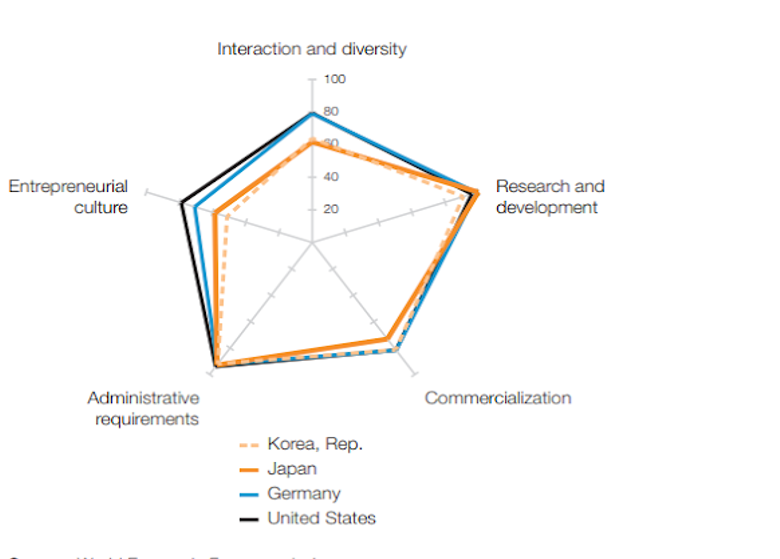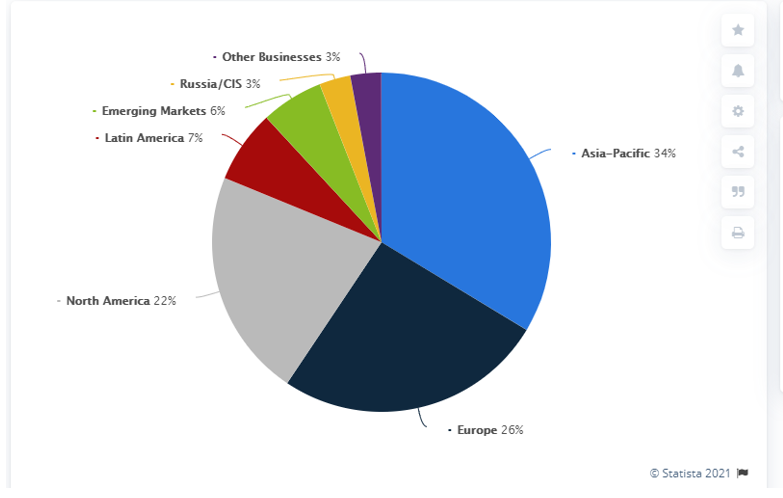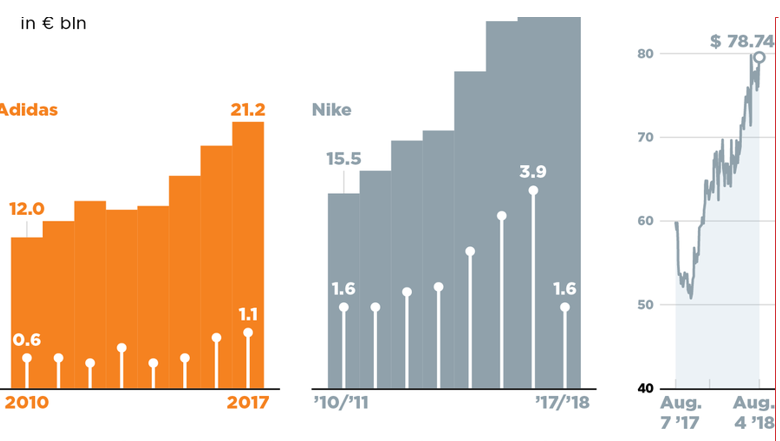Introduction
Background
Adidas’ founder, Adi Dassler, became passionate about providing athletes with quality apparel to improve their performance. He made the first pair of shoes in 1920 but registered a company four years later in a small town in Germany known as Bavaria. In 1949, Adi Dassler registered a new company, employing 47 workers in Herzogenaurach, which remains the company’s primary headquarters (Wright, 2019). In 2006, Adidas acquired Reebok after breaking a partnership with a Salomon and was renamed Adidas AG (Crasto et al., 2020). Although the company has established many branches worldwide, this paper will analyze, evaluate, and discuss the strategic issues in its central headquarters at Herzogenaurach, Germany.
Strategic Issues
Pestel Framework
Political Factors
It is expected that every multinational company is affected differently by the political climate in the countries it operates. The main political action impacting Adidas in Germany is related to advertisements. It has had several altercations where the government has banned or demanded that they remove controversial advertisements. Moreover, there have been continued tensions and extensive scrutiny on the messages and visuals in their marketing strategies. While Germany’s political climate has been relatively more relaxed than other European countries, there has been a recent spike in far-right extremism, creating considerable instability. Most of the civil altercations are fueled by explicit racist behavior.
Economic Factors
Adidas’ profitability in Germany has been regulated by taxation and the population’s per capita income. As a member of the European Economic Area, there are trade treaties, custom duties, and other trade regulations that influence the market forces. The move to take the country out of the EU has not been conclusive, and Germany remains an active member of the EU. As one of the world’s largest economies, Germany confers an environment with high living standards and social security (Klagge, Martin and Sunley, 2017). Generally, the business environment is controlled by supply and demand since it has a liberal market economy. Some regional programs grant operational incentives, but they are mostly given to startups for small and medium-sized enterprises. Lastly, aspects of market dominance are not restricted, but it is illegal for companies to abuse such advantages.
Social Factors
With more than 82 million residents, Germany has grown to be a multicultural country, accommodating diverse lifestyles. The country has hosted many international sports events, including FIFA and the Olympics. Since the company majors in the sports field, such events tend to have lucrative effects on its position. The most attractive aspect is that, as in most European countries, Germany has an increasing demand for fitness equipment and apparel, especially among the millennials and the older generations (Klagge, Martin, and Sunley, 2017). However, Germany’s ethnocultural atmosphere calls for deep considerations and research when it concerns implementing such marketing approaches as commercials.
Technological Factors
The technological environment in Germany is relatively high since it is a developed country. Notably, the country has been recognized as the leading producer of automotive and chemical goods. Therefore, it has created many R&D facilities that are used for both public and private research. With the noteworthy technological capacities, there are limitless chances for such a company as Adidas to facilitate creativity and innovation. Figure 1 shows high innovative capacities, through R&D, in Germany.

Legal Factors
As mentioned within the economic factors section, Germany remains to be a member state of the EU. Therefore, trade activities are governed by regulatory bodies that are within the EU jurisdiction.
Porter’s Five Forces
As shown in Figure 2, a significant portion of Adidas international sales comes from Western Europe, including Germany. The Porter analysis gives more detailed insights on how the company obtains and sustains a competitive edge over its rivals.

Bargaining Power of the Suppliers
As brand originating, deeply rooted, and highly recognized among the locals, Adidas has high bargaining power over its suppliers (Wright, 2019). Currently, Adidas has created a multilayered supply chain that helps it receive materials from both local and foreign sources. The consequence of its dominance over suppliers is that it set quality standards that enable it to manufacture quality products for its customers.
Bargaining Power of Buyers
In most sectors, consumer supremacy reigns when the market is saturated with competitors. However, in the field of sporting apparel and equipment in Germany, the consumers have a relatively moderate power over the brand. While there are substitute products from local and international competitors, the main rivalry is between Adidas and Nike, as shown in Figure 3.

The two have established a reputation for providing quality products and have a longstanding relationship with their customers. Moreover, with the increased market growth, Adidas fosters marketing campaigns that greatly influence its target market. The company has established a reputation on product design and performance merits that imbue considerable customer loyalty.
Threat of Substitutes
In this scope, the threat is relatively low. There are small local providers of substitute products in Germany who are mostly enabled by R&D programs. However, Adidas has invested unmatched innovations that produce meticulous products that are not easily replaced by substitutes (Crasto et al., 2020). Therefore, Adidas’ low-level threat is hedged on strong brand reputation, customer loyalty, quality products, designs, and effective marketing strategies.
The Threat of New Entrants
New brands may have a difficult task in making successful moves against dominant market shareholders such as Adidas. While Germany’s economic and technological environment may seem sufficient to foster startups’ growth in different ventures, Adidas’ dominance casts a dark shadow regarding investment in technology, human capital, and marketing. Therefore, it is a daunting task for interested parties to accumulate enough funds to introduce and sustain a new product within the same market segment.
Strategic Analysis
Corporate Strategy
The leadership framework has been consistent in facilitating commitment to the quality, performance, and cross-functional collaboration culture (Crasto et al., 2020). It had retained a uniform strategy until recently when it added three measures to improve its brand desirability. Central to its unique culture has been the aspect of diversity and inclusivity. Its dedication has been impressive, especially in managing inclusiveness amidst the rising cases of racial conflicts.
With its vast industry-leading experience, the company adopted three new measures to its corporate strategy. They include improving product availability speed to consumers, focusing on metropolitan regions, and adopting an open-source approach. The latter has an impressive framework that involves collaborations with athletes, partnering with experts in the sports industry, and making creative innovations (Holtbrügge and Haussman, 2017). With an acceleration plan centered on the mantra “Creating the New,” the company aims at increasing its reach by becoming actively engaged in improving experiences in the sports world.
Value Chain Analysis
Inbound Logistics
As a leading market player, Adidas has been outsourcing most of its manufacturing processes. The intention falls in line with its strategic move to increase the speed and efficiencies of production and product availability. By doing this, the company reduces not only inventory risk but also its costs. Subsequently, it manages to sustain competitive prices against other major players. It also has a comprehensively spread distribution network and is heavily dedicated to keeping a constant flow in its leading markets. In Germany, one of its largest distribution centers was expanded in 2019 to optimize the distribution network.
Operations
While Herzogenauch serves as the main headquarters, there are several other locations used to manage global operations. Some include Shanghai, Moscow, Costa del Este, Dubai, Boston, and Amsterdam (Holtbrügge and Haussman, 2017). As consumer touchpoints, they have helped the company to make a noticeable global footprint and function efficiently. Besides having a deep network of offices, stores, and warehouses, they facilitate the connections between distribution centers and e-fulfillment facilities.
Outbound Logistics
With distribution centers in key locations, the company has fostered efficiency and timeliness in satisfying consumer needs. The distribution centers and warehouses have been developed to also serve as fulfillment centers for online shoppers.
Marketing and Sales
Adidas conducts and has to retain heavy investments in marketing and advertisement. While the company dominates in the market share, it faces significant competition from the existing competitors (Wright, 2019). Despite the notable increase in sales in the recent past, the company cannot afford to be complacent. With the paradigm shift to online-oriented business models, the company has to increase its talent pool in digital marketing to avoid stunting its growth. Most of the current marketing expenditures are from commercial and sponsorship contracts (Laluyan, Pangemanan and Worang, 2017). There are also paid advertisements on social media platforms such as YouTube and Facebook. By devising new ways to keep the customers engaged, the company will strengthen its reputation and imbue sustainability and drive its sales.
Business-Level Strategy
By mentioning the world Adidas, there is a unique conception among the consumers about the brand. It is essential to acknowledge that through R&D capacities in Germany, the company has an easily distinguished profile from its rivals. In this regard, one can assert that the company has achieved broad differentiation. It has also adopted a consumer-centric approach to business to increase brand desirability (Matović, Stanić and Drinić, 2019). One unique way is through the sharpening of the core competencies, which are footwear and apparel. Additionally, this can be achieved by embracing digital transformation and continually improving the company’s capacities.
Results Analysis
Valuable
Sustainable, valuable strengths at Adidas AG are mainly the financial resources and the distribution network. Since the company has established a global footprint with increasing sales, it can sustain costs that put it above most of its lower-end competitors. To do this, the company would have to place its financial resources in combatting threats and identifying unique lucrative ventures, for instance, through continued facilitation of innovation in R&D facilities. Another valuable resource in the company is its workforce as well as leadership. The company has dedicated sufficient effort to create a culture that stimulates performance and commitment to its customers.
Rare
A few competitors only match Adidas’ financial capabilities. In Germany, for instance, the main rival equaling Adidas finances is Nike. While the environment may favor an entrepreneurial spirit, their firm lacks sufficient funds to spring up worthy competitors. Adidas’s intensive distribution network is unmatched by many companies in the industry (Crasto et al., 2020). Adidas ensured that it has a rare and fulfilled workforce by having a diverse and inclusive working environment.
Imitable
Apart from large companies such as Nike, most of Adidas’ competitors would have to obtain outrageous sales to reach Adidas financial capabilities. Therefore, a company that wants to compete simultaneously may only succeed out of a limited chance of luck. As a strong brand, Adidas has intense technological designs and quality products. Therefore, by patenting it work, Adidas would significantly reduce the issues of product and brand imitation (Kaseva, 2018). Imitable aspects of the company include employees and distribution networks. Rivals can tailor the training and educational needs to resemble those of the existing workforce. Moreover, through intensive research, a new company can learn and adopt the distribution network.
Organization
Adidas has placed a strategic move to imbue leadership skills in its workforce. Subsequently, they are expected to manage the available resources. By having a trained leadership team, the company makes a strategic decision to maintain an organized outlook. Other notable organizations are within the distribution network, tailored to meet the consumers’ speedy delivery of products. Together, the named factors reinforce Adidas’s chances of having an extended period of dominance in the industry.
SAFe
The recent surges in Adidas sales indicate promising growth prospects. Its competitive edge is primarily because of the investment in product quality, which is improved through innovativeness in R&D. Its outsourced and broad network of suppliers helps reduce operational costs and increase profits. It has an acceptable and inclusive work culture that works well for its leadership, subordinate body, and consumers. It has achieved brand dominance, excellence in using digital technology, high innovation, brand attractiveness, and consumer loyalty, factors that empower its feasibility and continued growth.
Recommendations and Conclusion
Notably, while Adidas dominates in the apparel industry, it has mostly focused on male-dominated facets. The female population is increasingly becoming empowered to participate in health and fitness classes. Nevertheless, the number of female athletes is increasing by the day. The company should consider creating a signature shoe or apparel for a new market segment. With the increasing health consciousness globally, the sports industry remains a lucrative venture for companies such as Adidas. Currently, it has created a reputation as a brand that supports quality and performance. With its inimitable and highly valuable traits, the company can reign but not for long. Therefore, they need to revise their strategic plans often. It is also admirable that the firm has established an effective distribution network. The involvement and upgrade in digital marketing have also had an impressive touch on the company’s success.
References
Crasto, S.G. et al. (2020) ‘Product innovation by Adidas Group through sustainability’, Journal of the Community Development in Asia, 3(1), pp. 1-7.
Holtbrügge, D. and Haussman, H. (eds.) (2017) The internationalization of firms: case studies from the Nürnberg Metropolitan region. Web.
Kaseva, I. (2018) Instagram as a digital marketing tool for fashion brands: case company: Adidas Originals. Bachelor’s thesis. Lahti University of Applied Sciences.
Klagge, B., Martin, R. and Sunley, P. (2017) ‘The spatial structure of the financial system and the funding of regional business: a comparison of Britain and Germany’, in Martin, R. and Pollard, J. (eds.) Handbook on the geographies of money and finance. Cheltenham: Edward Elgar Publishing, pp. 125-155.
Laluyan, W.N, Pangemanan, S.S. and Worang, F.G. (2017) ‘The effect of advertising, perceived quality and brand awareness on consumer purchase intention (Case study: Adidas sport shoes)’, Jurnal EMBA, 5(2), pp. 267-278.
Matović, V., Stanić, M. and Drinić, I. (2019) ‘Impact branding on consumer preference towards buying a certain product: comparative analysis of brands Nike and Adidas’, Ekonomika, 65(3), pp. 35-44.
Adidas sales share by region worldwide 2019 (no date). Web.
The Global Competitiveness Report 2018. In Depth: Is there a formula for innovation? Web.
Wright, M., (2019). Strategic Audit of Adidas, Honors Thesis. University of Nebraska, Lincoln.